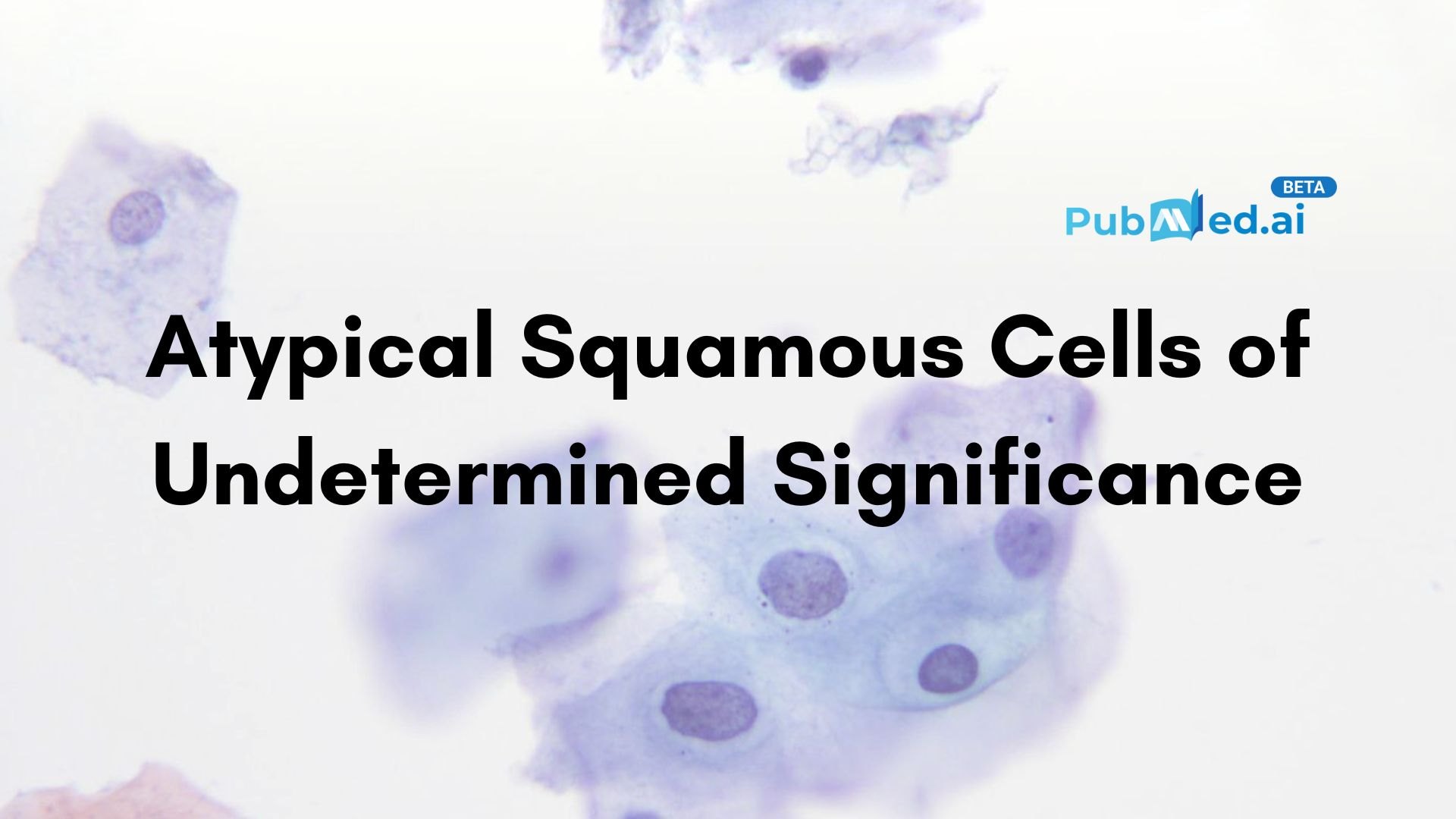Atypical Squamous Cells of Undetermined Significance (ASC-US)

In a Pap smear, the term “squamous cells” refers to the thin, flat cells that line the cervix.
Normally, these cells look uniform and orderly. But sometimes, cytologists find cells that don’t quite look normal—not definitively precancerous, but not entirely typical either. That’s ASC-US.
It’s a cautious way of saying: “We see some changes, but we’re not sure yet what they mean.”
Clinically, ASC-US falls under the Bethesda System category of epithelial cell abnormality.
You can explore related literature through PubMed.ai’s ASC-US database.
For reference, the National Cancer Institute (NCI) describes ASC-US as cells that appear slightly abnormal but are not clearly precancerous—a gray zone in cytologic interpretation.
2. Why Does ASC-US Happen?
Here’s the thing—ASC-US isn’t a diagnosis; it’s a signal.
Many factors can cause squamous cells to appear “atypical” under the microscope:
- HPV infection (especially transient types)
- Inflammation or infection (from bacteria, yeast, or trichomonas)
- Hormonal changes (e.g., during menopause or pregnancy)
- Recent sexual activity or irritation (even from tampons or medical procedures)
Not all atypical findings mean cancer. In fact, most resolve spontaneously.
But since HPV is the most common cause of abnormal cell changes, further testing is essential.
You can explore related HPV and cytology studies through PubMed.ai search or visit the PubMed.ai homepage for broader clinical data.
According to the Centers for Disease Control and Prevention (CDC), most HPV infections clear within two years, and only persistent infections pose significant cancer risks.
3. ASC-US and HPV: The Real Deciding Factor
If you only remember one thing, let it be this:
HPV testing determines what happens next.
- ASC-US with negative HPV: usually considered low-risk; doctors often recommend routine screening in 3 years.
- ASC-US with positive HPV: requires closer follow-up, often a colposcopy to examine cervical tissue under magnification.
In practice, clinicians use HPV triage testing to decide whether ASC-US needs immediate attention or simple observation.
If you want to review the clinical evidence, check out ASC-US studies on PubMed.ai.
4. Does ASC-US Mean Cancer?
No—and that’s the key reassurance.
ASC-US means “uncertain significance,” not “cancer.”
Think of it as a “gray zone” between normal and abnormal. Most ASC-US findings clear up naturally or remain stable.
However, persistent HPV infection or repeated abnormal results may indicate early precancerous changes, known as **CIN (cervical intraepithelial neoplasia)**.
To stay informed about how ASC-US findings are tracked over time, you can explore the term directly on PubMed.ai.
For global guidelines on cervical screening, the World Health Organization (WHO) provides comprehensive updates and recommendations.
5. Rare ASC-US Findings — When It’s Less Straightforward
Sometimes, cytologists note “rare atypical squamous cells” or “ASC-US, favor reactive.”
This phrasing usually means the sample shows very few abnormal cells, making interpretation even trickier.
Clinicians may recommend repeating the Pap test in 6 to 12 months to monitor cell behavior.
For deeper understanding of cytologic interpretations, explore ASC-US cytology resources.
6. ICD-10 Coding and Clinical Classification
For clinical documentation, ASC-US corresponds to ICD-10 code R87.619, listed under “unspecified abnormal cytological findings in specimens from the cervix uteri.”
It’s primarily a screening code, not a diagnostic one.
Medical coders and researchers can find terminology guidance by visiting the PubMed.ai homepage for access to standardized reference materials and medical coding examples.
7. Management: What Happens After ASC-US?
Management depends heavily on HPV status and patient age.
Here’s a simplified overview used in most current guidelines:
- If HPV-negative: Repeat Pap in 3 years (routine screening)
- If HPV-positive: Colposcopy or HPV genotyping (especially for HPV 16/18)
- If under 25 years old: Repeat testing in 12 months rather than immediate colposcopy
You can verify the evidence base for these recommendations using the PubMed.ai search tool.
8. Emotional Perspective — Should You Be Worried?
It’s easy to panic when you read *“abnormal result”*, but ASC-US is often just a cautious note.
Doctors use this label to avoid overcalling a normal change as disease.
In many cases, repeat testing shows the cervix returns to normal without any intervention.
Still, the finding shouldn’t be ignored—it’s a signal to monitor, not a sentence to fear.
You can read balanced, peer-reviewed discussions on this topic in the PubMed.ai clinical database.
FAQs
1. What does atypical squamous cells of undetermined significance mean?
It means cervical cells look slightly abnormal under a microscope but not definitively precancerous or malignant.
2. What causes atypical squamous cells of undetermined significance?
Most cases are related to HPV infection, but inflammation, hormones, or benign irritation can also cause it.
3. Does ASC-US mean I have cancer?
No. ASC-US alone doesn’t indicate cancer. It signals uncertain changes that usually require repeat testing or HPV evaluation.
4. How is ASC-US treated?
Treatment depends on the cause. If HPV-negative, observation is typical. If HPV-positive, follow-up with colposcopy may be recommended.
5. What if my ASC-US result is rare or unclear?
Your clinician may recommend a repeat Pap smear in 6–12 months to reassess. You can check ASC-US studies on PubMed.ai for research updates.
Further Reading
If you want to explore current cervical cytology research, visit the PubMed.ai search page or review topic-specific findings on atypical squamous cells of undetermined significance.
Disclaimer:
The content in this article is for informational and educational purposes only. It is not intended to provide medical advice, diagnosis, or treatment. Always consult qualified healthcare professionals regarding any medical condition or treatment decisions.

Have a question about medical research, clinical practice, or evidence-based treatment? Access authoritative, real-time insights: PubMed.ai is an AI-Powered Medical Research Assistant.
Your AI Medical Update
Subscribe to our free Newsletter